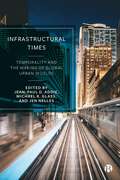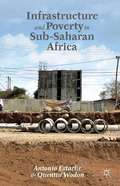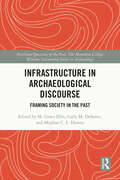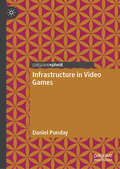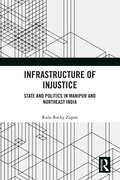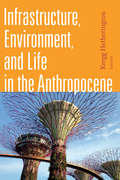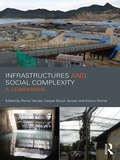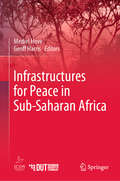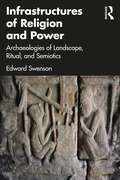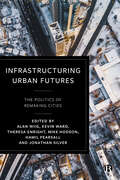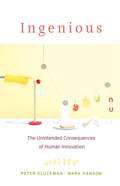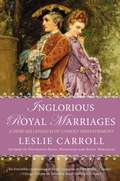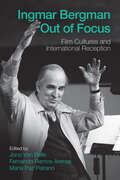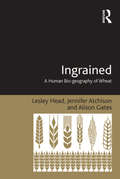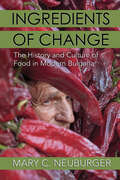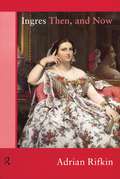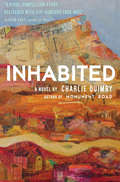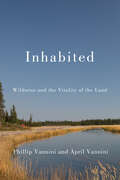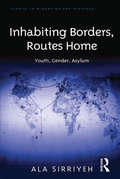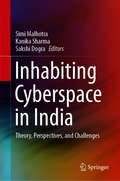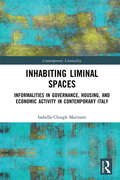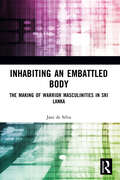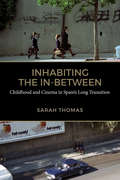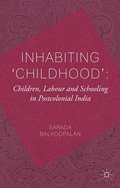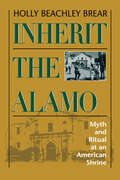- Table View
- List View
Infrastructural Times: Temporality and the Making of Global Urban Worlds
by Jean-Paul D. Addie, Michael R. Glass, and Jen NellesWhether waiting for the train or planning the future city, infrastructure orders—and depends on—multiple urban temporalities. This agenda-setting volume disrupts conventional notions of time through a robust examination of the relations between temporality, infrastructure, and urban society. Conceptually rich and empirically detailed, its interdisciplinary dialogue encompasses infrastructural systems including transportation, energy, and water to bridge often-siloed technical, political-economic and lived perspectives. With global coverage of diverse cities and regions from Berlin to Jayapura, this book is an essential provocation to re-evaluate urban theory, politics, and practice and better account for the temporal complexities that shape our infrastructured worlds.
Infrastructure and Poverty in Sub-Saharan Africa
by Quentin Wodon Antonio EstacheInfrastructure and Poverty in Sub-Saharan Africa analyzes the extent to which, how, and how fast the infrastructure needs of the poor have been met in Sub-Saharan Africa. Estache and Wodon explore the extent to which some key policies have hurt or helped progress in trying to speed the expansions of coverage so clearly needed in the region. They focus on electricity, water, sanitation, and other services at the core of the day-to-day needs of the population, examining the extent to which reforms of the last 15-20 years have managed to reduce the infrastructure gap. They anchor their analysis on the evidence available about the macroeconomic importance of infrastructure for the region, the policies that have been adopted to accelerate coverage, and a detailed assessment of the poverty dimensions of infrastructure.
Infrastructure in Archaeological Discourse: Framing Society in the Past (Persistent Questions of the Past)
by M. Grace Ellis Carly M. DeSanto Howey, Meghan C. L.This volume expands perspectives on infrastructure that are rooted in archaeological discourse and material evidence.The compiled chapters represent new and emerging ideas within archaeology about what infrastructure is, how it can materialize, and how it impacts and reflects human behavior, social organization, and identity in the past as well as the present. Three goals central to the work include: (1) expand the definition of infrastructure using archaeological frameworks and evidence from a wide range of social, historical, and geographic contexts; (2) explore how new archaeological perspectives on infrastructure can help answer anthropological questions pertaining to social organization, group collaboration, and community consensus and negotiation; and (3) examine the broader implications of an archaeological engagement with infrastructure and contributions to contemporary infrastructural studies. Chapters explore important aspects of infrastructure, including its relationality, scale, history, and relevance, and provide archaeological case studies that examine the social repercussions of infrastructure and the various ways it has materialized in the past. This compilation ultimately expands the discourse of infrastructure in archaeology and social sciences more broadly.Social scientists can turn to this volume for insights into an archaeologically informed perspective on infrastructure relevant to the study of past and current human behavior.
Infrastructure in Video Games
by Daniel PundayThis book will sketch the dynamics of infrastructure in video games, focusing on the relationship between game rules, fictional world, and player interaction. It will discuss a variety of commercial video games, both mainstream and somewhat niche, that use infrastructure in different ways: Control, Wolfenstein, Fallout, This War of Mine, Exocolonist, Cyberpunk, and Frostpunk. Video games offer a particularly rich field for thinking about the relationship between narrative and infrastructure. The infrastructures that exist in the fictional worlds of these games define the experience of play in a very direct way: how players are instantiated in the game, how they move around the play space, the resources that are available, and so on. And those infrastructures in turn very directly definite the nature of the fictional world. In contrast to literary fiction, were infrastructures might remain on the periphery of some stories, by virtue of the centrality of player interaction video games are inherently infrastructural.
Infrastructure of Injustice: State and Politics in Manipur and Northeast India
by Raile Rocky ZiipaoThis book examines the dynamics of infrastructure development in Northeast India especially Manipur from a socio-anthropological perspective. It looks at the pattern and distribution of infrastructure in the region to analyse the impact of education, roads and healthcare on the livelihoods, ecosystems, governance, and social futures of communities. The volume examines the infrastructure deficit in the conflict-ridden state of Manipur, focusing especially on electricity and roads. The author shows how problems arising from poor infrastructure are further complicated on account of corruption, insurgency, ethnic unrest and the politics of marginalization. Looking at the discourse around development in the Northeast, the volume also highlights the structural inequality in Manipur and other states. It further shows how infrastructure development can become a means for enabling trade, creating markets, diluting boundaries between varied ethnic groups and connecting people. This book will be useful for researchers and scholars of development studies, economics, social anthropology, sociology and public policy; particularly those interested in India’s Northeast.
Infrastructure, Environment, and Life in the Anthropocene (Experimental Futures)
by Kregg HetheringtonInfrastructure, Environment, and Life in the Anthropocene explores life in the age of climate change through a series of infrastructural puzzles—sites at which it has become impossible to disentangle the natural from the built environment. With topics ranging from breakwaters built of oysters, underground rivers made by leaky pipes, and architecture gone weedy to neighborhoods partially submerged by rising tides, the contributors explore situations that destabilize the concepts we once relied on to address environmental challenges. They take up the challenge that the Anthropocene poses both to life on the planet and to our social-scientific understanding of it by showing how past conceptions of environment and progress have become unmoored and what this means for how we imagine the future. Contributors. Nikhil Anand, Andrea Ballestero, Bruce Braun, Ashley Carse, Gastón R. Gordillo, Kregg Hetherington, Casper Bruun Jensen, Joseph Masco, Shaylih Muehlmann, Natasha Myers, Stephanie Wakefield, Austin Zeiderman
Infrastructures and Social Complexity: A Companion (CRESC)
by Casper Bruun Jensen Atsuro Morita Penelope HarveyContemporary forms of infrastructural development herald alternative futures through their incorporation of digital technologies, mobile capital, international politics and the promises and fears of enhanced connectivity. In tandem with increasing concerns about climate change and the anthropocene, there is further an urgency around contemporary infrastructural provision: a concern about its fragility, and an awareness that these connective, relational systems significantly shape both local and planetary futures in ways that we need to understand more clearly. Offering a rich set of empirically detailed and conceptually sophisticated studies of infrastructural systems and experiments, present and past, contributors to this volume address both the transformative potential of infrastructural systems and their stasis. Covering infrastructural figures; their ontologies, epistemologies, classifications and politics, and spanning development, urban, energy, environmental and information infrastructures, the chapters explore both the promises and failures of infrastructure. Tracing the experimental histories of a wide range of infrastructures and documenting their variable outcomes, the volume offers a unique set of analytical perspectives on contemporary infrastructural complications. These studies bring a systematic empirical and analytical attention to human worlds as they intersect with more-than-human worlds, whether technological or biological.
Infrastructures for Peace in Sub-Saharan Africa
by Mediel Hove Geoff HarrisCultures of violence are characteristic of many countries in sub-Saharan Africa and attempts to move towards cultures of peace have often proved difficult and ineffectual. And yet, the wide variations in levels of violence within and between countries show that it is not inevitable; rather, it is the result of choices made at individual, community and societal levels. This book examines the potential of peace infrastructures as vehicles to strengthen and spread progress towards cultures of peace. Peace infrastructures vary hugely in sophistication and level. The examples examined in this book range from tiny structures which help resolve conflicts between individuals and within community organisations, peace committees which serve local communities, peace education and peace club programmes in schools, mediation mechanisms to prevent election violence and to ministries of peace to coordinate government and non-government efforts in peacemaking and peacebuilding. The overall finding is that the development of peace infrastructures at all levels has great potential to build cultures of peace. 1. It is the only book available which documents the experience and potential of nonviolence in post-independence sub-Saharan Africa. 2. It makes a persuasive case for the development of various peace infrastructures in order to make peace sustainable. 3. It explains how strategic planning can be utilised, both to bring about change and to institutionalise it.
Infrastructures of Religion and Power: Archaeologies of Landscape, Ritual, and Semiotics
by Edward SwensonThis book explores the central role of religion in place-making and infrastructural projects in ancient polities. It presents a trilectic approach to archaeological study of religious landscapes that combines Indigenous philosophies with the spatial and semiotic thinking of Lefebvre, Peirce, and proponents of assemblage theories. Case studies from ancient Angkor and the Andes reveal how rituals of place-making activated processes of territorialization and semiosis fundamental to the experience of political worlds that shaped power relations in past societies. The perspectives developed in the book permit a reconstruction of how landscapes were variably conceived, perceived, and lived in the spirit of Henri Lefebvre, and how these registers may have aligned or clashed. In the end, the examination of built environments, infrastructures, and rituals staged within specialized buildings demonstrates how archaeologists can better infer past ontologies, cosmologies, ideologies of time and place, and historically specific political struggles. The study will appeal to students and researchers interested in ritual, infrastructures, landscape, archaeological theory, political institutions, semiotics, human geography, and the civilizations of the ancient Andes and Angkor.
Infrastructuring Urban Futures: The Politics of Remaking Cities
by Alan Wiig, Kevin Ward, Theresa Enright, Mike Hodson, Hamil Pearsall and Jonathan SilverEPDF and EPUB available Open Access under CC-BY-NC-ND licence. Focusing on material and social forms of infrastructure, this edited collection draws on rich empirical details from cities across the global North and South. The book asks the reader to think through the different ways in which infrastructure comes to be present in cities and its co-constitutive relationships with urban inhabitants and wider processes of urbanization. Considering the climate emergency, economic transformation, public health crises and racialized inequality, the book argues that paying attention to infrastructures’ past, present and future allows us to understand and respond to the current urban condition.
Ingenious: The Unintended Consequences of Human Innovation
by Peter Gluckman Mark HansonThe trouble with innovation is that it can seldom be undone. We invent technologies to modify our environments in immediately beneficial ways, but the long-term consequences can be costly. From obesity to antibiotic resistance, we pay for our successes. Peter Gluckman and Mark Hanson explore what happens when our creations lead nature to bite back.
Inglorious Royal Marriages
by Leslie CarrollIt's no secret that the marriages of monarchs are often made in hell. Here are some of the most spectacular mismatches in five hundred years of royal history.... In a world where many kings, queens, and princes lacked nothing but true love, marital mismatches could bring out the baddest, boldest behavior in the bluest of bloodlines. Margaret Tudor, her niece Mary I, and Catherine of Braganza were desperately in love with chronically unfaithful husbands, but at least they weren't murdered by them, as were two of the Medici princesses were. King Charles II's beautiful, high-spirited sister "Minette" wed Louis XIV's younger brother, who wore more makeup and perfume than she did. Forced to wed her boring, jug-eared cousin Ferdinand, Marie of Roumania--a granddaughter of Queen Victoria--proved herself one of the heroines of World War I by using her prodigious personal charm to regain massive amounts of land during the peace talks at Versailles. Brimming with outrageous real-life stories of royal marriages gone wrong, this is an entertaining, unforgettable book of dubious matches doomed from the start.
Ingmar Bergman Out of Focus: Film Cultures and International Reception
by Jono Van Belle, Fernando Ramos Arenas, and María Paz PeiranoDirector Ingmar Bergman occupies a central place in the history of modern cinema. Credited with igniting a cinematic revolution, his ability to produce work which resonated with audiences globally has brought scholarly attention to the impact of Bergman’s Swedish background on his oeuvre. Ingmar Bergman Out of Focus revises this question of Bergman’s “familiarity” to produce a more expansive understanding of Bergman’s cultural heritage. Considering the impact of Bergman’s films on film festival organizers, critics, academics, and audiences all over the world, this volume illuminates how Bergman’s film aesthetics simultaneously shaped modern culture and were themselves reshaped by the debates and concerns that preoccupied his viewers.
Ingrained: A Human Bio-geography of Wheat
by Lesley Head Jennifer AtchisonPlants are fundamental players in human lives, underpinning our food supply and contributing to the air we breathe, but they are easy to take for granted and have received insufficient attention in the social sciences. This book advances understanding of human-plant relations using the example of wheat. Theoretically, this book develops new insights by bringing together human geography, biogeography and archaeology to provide a long term perspective on human-wheat relations. Although the relational, more-than-human turn in the social sciences has seen a number of plant-related studies, these have not yet fully engaged with the question of what it means to be a plant. The book draws on diverse literatures to tackle this question, advancing thinking about how plants act in their worlds, and how we can better understand our shared worlds. Empirically, the book reports original ethnographic research on wheat production, processing and consumption in a context of globalisation, drought and climate change and traces the complex networks of wheat using a methodology of 'following' it and its people. The ethnobotanical study captures a number of moments in the life of Australian wheat; on the farm, at the supermarket, in the lives of coeliac sufferers, in laboratories and in industrial factories. This study demands new ways of thinking about wheat geographies, going beyond the rural landscape to urban and industrial frontiers, and being simultaneously local and global in perspective and connection.
Ingredients of Change: The History and Culture of Food in Modern Bulgaria
by Mary C. NeuburgerIngredients of Change explores modern Bulgaria's foodways from the Ottoman era to the present, outlining how Bulgarians domesticated and adapted diverse local, regional, and global foods and techniques, and how the nation's culinary topography has been continually reshaped by the imperial legacies of the Ottomans, Habsburgs, Russians, and Soviets, as well as by the ingenuity of its own people. Changes in Bulgarian cooking and cuisine, Mary C. Neuburger shows, were driven less by nationalism than by the circulation of powerful food narratives—scientific, religious, and ethical—along with peoples, goods, technologies, and politics. Ingredients of Change tells this complex story through thematic chapters focused on bread, meat, milk and yogurt, wine, and the foundational vegetables of Bulgarian cuisine—tomatoes and peppers. Neuburger traces the ways in which these ingredients were introduced and transformed in the Bulgarian diet over time, often in the context of Bulgaria's tumultuous political history. She shows how the country's modern dietary and culinary transformations accelerated under a communist dictatorship that had the resources and will to fundamentally reshape what and how people ate and drank.
Ingres Then, and Now (Re Visions Ser.)
by Adrian RifkinIngres Then, and Now is an innovative study of one of the best-known French artists of the nineteenth century, Jean Auguste Dominique Ingres. Adrian Rifkin re-evaluates Ingres' work in the context of a variety of literary, musical and visual cultures which are normally seen as alien to him. Re-viewing Ingres' paintings as a series of fragmentary symptoms of the commodity cultures of nineteenth-century Paris, Adrian Rifkin draws the artist away from his familiar association with the Academy and the Salon.Rifkin sets out to show how, by thinking of the historical archive as a form of the unconscious, we can renew our understanding of nineteenth-century conservative or academic cultures by reading them against their 'other'. He situates Ingres in the world of the Parisian Arcades, as represented by Walter Benjamin, and examines the effect of this juxtaposition on how we think of Benjamin himself, following Ingres' image in popular cultures of the twentieth century. Rifkin then returns to the late eighteenth and early nineteenth centuries to find traces of the emergence of bizarre symptoms in Ingres' early work, symptoms which open him to a variety of conflicting readings and appropriations. It concludes by examining his importance for the great French art critic Jean Cassou on the one hand, and in making a bold, contemporary gay appropriation on the other.Ingres Then, and Now transforms the popular image we have of Ingres. It argues that the figure of the artist is neither fixed in time or place - there is neither an essential man named Ingres, nor a singular body of his work - but is an effect of many, complex and overlapping historical effects.
Inhabited
by Charlie Quimby"Charlie Quimby is a writer with a big talent, big heart, and big social conscience. In his second novel, Inhabited, characters finely drawn and memorable live amidst the crisscrossing lines of moral conscience, political juggling and economic expediency, a tough neighborhood. I was staggered by the authenticity of these people and their dilemmas."-FAITH SULLIVAN, author of Goodnight, Mr. Wodehouse and The Cape Ann"Charlie Quimby is the sharpest shooter in the West. Inhabited is a dramatic, honest, humane portrait of a Colorado city in the throes of great change and great choice. The characters and the setting are indelibly rendered...We're all in the mix here-rich and poor, homeless and over-housed, rancher and eco-activist, native politician and outside scoundrel. Inhabited is a vivid, compelling story delivered with 21st-century true grit."-ALYSON HAGY, author of Boleto"A thoroughly enjoyable novel that masterfully takes the reader on an emotionally rewarding exploration of 'home' and the power the concept has on the human psyche."-JONATHAN ODELL, author of Miss Hazel and the Rosa Parks League"Inhabited transforms a typical community 'homeless problem' into a layered drama about our responsibilities to each other and the blunders and scars we must endure. I salute Charlie Quimby for following the path of Steinbeck and Orwell in writing empathetic portraits of the ignored and the shunned."-JIM LYNCH, author of Before the WindMeg Mogrin sells pricey houses, belongs to the mayor's inner circle, and knows more than she's letting on about her sister's death. Isaac Samson lives in a tent and believes Thomas Edison invented the Reagan presidency. When their town attracts a game-changing development, Isaac is displaced by the town's crackdown on vagrancy. As Isaac struggles to regain stability, Meg contends with conflicting roles of assisting the developer while serving on the homeless coalition. Isaac's quest to return a lost artifact soon intrudes into Meg's tidy world, digging up a part of her past she'd rather remained buried. Inhabited, a sister novel to Charlie Quimby's acclaimed Monument Road, returns to the Grand Valley of western Colorado to explore the dimensions of loss, the boundaries of compassion, and the endurance of love.Charlie Quimby is the author of Monument Road, an Indie Next List pick and Booklist Editors' Choice in 2013. He began his writing career as playwright and arts journalist, veered into corporate communications and then founded a marketing agency that now purrs along without him. Along the way, he collected awards and developed the notion he had a few good novels in him. A native Coloradan and adopted Minnesotan, he is at home in both places.
Inhabited: Wildness and the Vitality of the Land
by Phillip Vannini April VanniniPeople are key elements of wild places. At the same time, human entanglements with wild ecologies involve extractivism, the growth of resource-based economies, and imperial-colonial expansion, activities that are wreaking havoc on our planet.Through an ethnographic exploration of Canada’s ten UNESCO Natural World Heritage sites, Inhabited reflects on the meanings of wildness, wilderness, and natural heritage. As we are introduced to local inhabitants and their perspectives, Phillip Vannini and April Vannini ask us to reflect on the colonial and dualist assumptions behind the received meaning of wild, challenging us to reimagine wildness as relational and rooted in vitality. Over the three years they spent in and around these sites, they learned from Indigenous and non-Indigenous peoples about their entanglements with each other and with non-human animals, rocks, plants, trees, sky, water, and spirits. The stories, actions, and experiences they encountered challenge conventional narratives of wild places as uninhabited by people and disconnected from culture and society. While it might be tempting to dismiss the idea of wildness as outdated in the Anthropocene era, Inhabited suggests that rethinking wildness offers a better – if messier – way forward.Part geography and anthropology, part environmental and cultural studies, and part politics and ecology, Inhabited balances a genuine love of nature’s vitality with a culturally responsible understanding of its interconnectedness with more-than-human ways of life.
Inhabiting Borders, Routes Home: Youth, Gender, Asylum (Studies in Migration and Diaspora)
by Ala SirriyehIn recent years there has been growing interest in the experiences of young people seeking asylum in Europe. While the significance of the role of age is recognized, both youth transitions and trajectories beyond the age of eighteen are still largely unexplored, the role and impact of mobility predominantly centering on experiences of movement from country of origin to country of settlement. Inhabiting Borders, Routes Home contends that in considering migration and settlement experiences of young refugees it is also important to consider the role of their mobility through age and transitions in the country of settlement. Based on narrative research with young refugees, this book explores how migration journeys are intertwined with life course journeys and transitions into adulthood, shedding light on the manner in which gender intersects with age in experiences of migration and settlement, with close attention to the processes by which 'home' is understood and constructed. Through the concept of 'home' the book draws together and reflects on interconnections between integration in areas such as education or housing and experiences of social networks. Examining experiences of the asylum process and the manner in which they are interwoven within a wider narrative of home both within and beyond, Inhabiting Borders, Routes Home will be of interest to social scientists working in the areas of migration, asylum, intersectionality and the life course.
Inhabiting Cyberspace in India: Theory, Perspectives, and Challenges
by Kanika Sharma Simi Malhotra Sakshi DograThis book gathers a selection of essays on the multifaceted aspects of cyber culture in India, both online and offline. It presents an in-depth analysis of cyberspace and its components, while also exploring its lived reality. The respective contributions highlight theoretical perspectives that address questions of relationality regarding all aspects of cyber culture in India, from the physical to the virtual. Bearing in mind India’s vast cultural diversity, which is shaped by different levels of political, social, and economic development, the book offers nuanced studies that analyze the complexities of cyberspace and digital culture in India. The book appeals to all readers interested in technology, cultural studies, online communication networks, feminism, virtual diasporas, and sociology.
Inhabiting Liminal Spaces: Informalities in Governance, Housing, and Economic Activity in Contemporary Italy (Contemporary Liminality)
by Isabella Clough MarinaroThis book draws together debates from two burgeoning fields, liminality and informality studies, to analyze how dynamics of rule-bending take shape in Rome today. Adopting a multiscalar and transdisciplinary approach, it unpacks how gaps and contradictions in institutional rulemaking and application force many residents into protracted liminal states marked by intense vulnerability. By merging a political economy lens with ethnographic research in informal housing, illegal moneylending, unauthorized street-vending and waste collection, the author shows that informalities are not marginal or anomalous conditions, but an integral element of the city’s governance logics. Multiple actors together construct the local cultural norms, conventions and moral economies through which rule-negotiation occurs. However, these practices are ultimately unable to reconfigure historically rooted power dynamics and hierarchies. In fact, they often aggravate weak urbanites’ difficulties in accessing rights and services. A study that challenges assumptions that informalities are predominantly features of developing economies or limited to specific groups and sectors, this volume’s critical approach and innovative methodology will appeal to scholars of sociology and anthropology interested in social theory, urban studies and liminality.
Inhabiting an Embattled Body: The Making of Warrior Masculinities in Sri Lanka
by Jani de SilvaThis book offers an anthropological account of Sri Lanka’s Eelam Wars III and IV. It is based on the life-narratives of ex-servicemen who fought on the frontlines. The volume approaches militarism as a practice of masculinity. It explores the sense of embattlement that young recruits feel, which stems from the inner war between notions of bodily deference instilled in childhood and having to conduct offensives on the battlefield. Thus though they wish to move smoothly into the assault techniques learnt in combat-training, they sometimes find their bodies are acting-out a different trajectory; engaging in acts of spectacular violence or simply running away. It traverses themes such as masculinity and Sinhala society, British martial masculinity vs the composed body in Sinhala discourse, combat-training and the battlefield. The author traces the ways in which troops tried to negotiate the thin line between valour and violence in a context in which the enemy’s suicide fighters engaged in the more extreme code of sacrificing-the-body, which derided the very manliness of soldiers who couldn’t prevail against them. She argues that the Sri Lankan experience has resonance for soldiers on battlefields everywhere, who become embattled when confronted by adversaries whose practice seems to diminish their own manliness. Rich in ethnographical narratives, this book will be interest scholars and researchers of war studies, gender studies, masculinity studies, peace and conflict studies, ethnic studies, political science, international relations, sociology, social anthropology, cultural studies, and South Asian studies, especially those concerned with Sri Lanka.
Inhabiting the In-Between: Childhood and Cinema in Spain’s Long Transition (Toronto Iberic)
by Sarah ThomasAlthough children have proliferated in Spain’s cinema since its inception, nowhere are they privileged and complicated in quite the same way as in the films of the 1970s and early 1980s, a period of radical political and cultural change for the nation as it emerged from almost four decades of repressive dictatorship under the rule of General Francisco Franco. In Inhabiting the In-Between: Childhood and Cinema in Spain’s Long Transition, Sarah Thomas analyzes the cinematic child within this complex historical conjuncture of a nation looking back on decades of authoritarian rule and forward to an uncertain future. Examining films from several genres by four key directors of the Transition – Carlos Saura, Antonio Mercero, Víctor Erice, and Jaime de Armiñán – Inhabiting the In-Between explores how the child is represented as both subject and object, self and other, and consistently cast in a position between categories or binary poles. Its readings demonstrate how the cinematic child that materializes in this period is a fundamentally shifting, oscillating, ambivalent figure that points toward the impossibility of fully comprehending the historical past and the figure of the other, while inviting an ethical engagement with each.
Inhabiting ‘Childhood’
by Sarada BalagopalanThrough a rich ethnography of street and working children in Calcutta, India, this book offers the first sustained enquiry into postcolonial childhoods, arguing that the lingering effects of colonialism are central to comprehending why these children struggle to inhabit the transition from labour to schooling.
Inherit the Alamo: Myth and Ritual at an American Shrine
by Holly Beachley BrearLong overshadowed by the towering buildings of downtown San Antonio, the modest little Alamo still evokes tremendous feeling among Texans and, indeed, many other Americans. For Anglo Texans, the Alamo is the "Cradle of Texas Liberty" and a symbolic confirmation of Manifest Destiny. For Hispanic Texans, however, the Alamo has increasingly become a stolen symbol, its origin as a Spanish mission forgotten, its famous defeat used to exclude Hispanics from an honorable place in Texas history. <P><P> In this important new book, Holly Beachley Brear explores in fascinating detail what the Alamo means to the numerous groups that lay claim to its heritage. She shows how Alamo myths often diverge from the historical facts--and why. She decodes the agendas of various groups, including the Daughters of the Republic of Texas (who maintain the Alamo buildings and grounds), the Order of the Alamo, the Texas Cavaliers, and LULAC. And she probes attempts by individuals and groups to rewrite the Alamo myth to include more positive roles for themselves, as she explains the value in laying claim to the Alamo's past.
